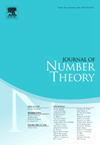签名为(2,1)的d4 -四次数域的单位格
IF 0.7
3区 数学
Q3 MATHEMATICS
引用次数: 0
摘要
最近,由于单位格在数论中的应用和缺乏已知结果,人们对单位格形状在数域中的分布产生了浓厚的兴趣。本文主要研究具有(2,1)特征的d4 -四次场;这样的字段有一个等级为2的单元组。将单位格看成GL2(Z)\h的一个点,证明了以这种方式产生的每一个格必须对应于GL2(Z)\h的某个基本域的边界上的一个超越点。此外,我们还得到了GL2(Z)\h的三个显式(代数)点,它们是签名为(2,1)的d4 -四次域的单位格(相关点)集合的极限点。本文章由计算机程序翻译,如有差异,请以英文原文为准。
Unit lattices of D4-quartic number fields with signature (2,1)
There has been a recent surge of interest on distributions of shapes of unit lattices in number fields, due to both their applications to number theory and the lack of known results.
In this work we focus on -quartic fields with signature ; such fields have a rank 2 unit group. Viewing the unit lattice as a point of , we prove that every lattice which arises this way must correspond to a transcendental point on the boundary of a certain fundamental domain of . Moreover, we produce three explicit (algebraic) points of which are limit points of the set of (points associated to) unit lattices of -quartic fields with signature .
求助全文
通过发布文献求助,成功后即可免费获取论文全文。
去求助
来源期刊

Journal of Number Theory
数学-数学
CiteScore
1.30
自引率
14.30%
发文量
122
审稿时长
16 weeks
期刊介绍:
The Journal of Number Theory (JNT) features selected research articles that represent the broad spectrum of interest in contemporary number theory and allied areas. A valuable resource for mathematicians, the journal provides an international forum for the publication of original research in this field.
The Journal of Number Theory is encouraging submissions of quality, long articles where most or all of the technical details are included. The journal now considers and welcomes also papers in Computational Number Theory.
Starting in May 2019, JNT will have a new format with 3 sections:
JNT Prime targets (possibly very long with complete proofs) high impact papers. Articles published in this section will be granted 1 year promotional open access.
JNT General Section is for shorter papers. We particularly encourage submission from junior researchers. Every attempt will be made to expedite the review process for such submissions.
Computational JNT . This section aims to provide a forum to disseminate contributions which make significant use of computer calculations to derive novel number theoretic results. There will be an online repository where supplementary codes and data can be stored.
 求助内容:
求助内容: 应助结果提醒方式:
应助结果提醒方式:


